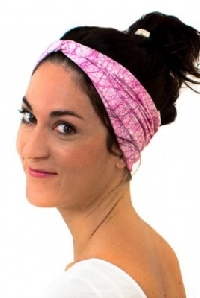
Head bands add fashion and practicality to busy lifestyles
Head bands aren?t just for hippies, baby girls, or very young women any more. Whatever your age, head bands are practically a necessity for today?s busy lifestyles.
Whether heading out to the gym, a yoga class, a quick run to the grocery store, or driving the kids to school, a head band is just the thing to keep your hair out of your eyes or camouflage a bad hair day.
Your head band needs to fit, stay put, and be comfortable to wear. Soft, lightweight stretchy fabrics make great fabrics for head bands.
Types of head band fabrics
The stretchiest head band fabrics are made of polyester-lycra blends, polyester-PBT (polybutylene terephthalate) blends, nylon-lycra blends, and cotton-lycra blends. All come in a variety of colors, prints, and patterns.
~
Other soft but less stretchy fabrics include:
- chiffons ? lightweight translucent mesh-like woven fabrics made of cotton, silk, nylon, rayon, or polyester;
- cottons ? sturdy fabrics made of 100% natural vegetable fibers;
- gabardines ? heavy ridged fabrics made of cotton, wool, or rayon;
- jerseys ? soft lightweight fabrics made of wool, rayon, or synthetics;
- knits ? soft lightweight fabrics made of cotton, wool, silk, linen, rayon, acetate, polyester, nylon, or acrylic;
- tweeds ? coarse heavy mixed-color fabrics made of wool;
- wools ? heavy fabrics traditionally made from sheep?s fleeces.
Don?t forget the dressier fabrics:
- cashmere ? made from the hair of Indian cashmere goats;
- mohair ? made from the hair of North African angora goats;
- crepes ? textured, finely wrinkled, matte-finished fabrics made of silk, wool, or synthetics;
- laces ? fancy open-weave fabrics made with linen, silk, or metallic threads;
- satins ? heavy lustrous fabrics made of silk, wool, or polyester;
- silks ? smooth lustrous fabrics made of protein fibers produced by various types of silkworms in China, India, and other Asian countries;
- taffetas ? smooth shimmering fabrics made of silk or rayon;
- velvets ? soft napped fabrics made of silk, silk-rayon blends, cotton, polyester, nylon, viscose, or acetate.
Head band styles
Soft head bands are worn around the head from your forehead (or slightly behind your hairline) to the nape of your neck, with the seam or closure underneath your hair. They range in width from very narrow to very wide.
Other soft bands, a/k/a sweatbands, are worn around your forehead horizontally and are used to keep the sweat out of your eyes when engaged in strenuous physical activities or games.
Turbans are also soft and quite wide. They?re worn the same way as traditional soft head bands except that their closure is at the top of your head. Closures are often embellished with a bow, flower, or other decorative flourish.
Scarf-type turbans are tied at the nape of your neck, underneath your hair.
Colorful plastic or acrylic ?horseshoe? head bands can be a solid color or a mixed-color or patterned design. They are worn an inch or more back from your hairline and extend to just above your ears. Often they have ?teeth? on the underside to keep them in place.
Making sewn head bands
If you choose to make your own head bands you can find free patterns online.
After deciding on your pattern, the first thing to do is to buy your fabric of choice. You?ll also need scissors, a cutting board, a rotary cutter, pins, and of course a sewing machine and the appropriately colored threads.
If you?ve chosen a jersey fabric, you can find instructions and tips here.
You can also find complete instructions for making other kinds of head bands here.
Making no-sew head bands
If sewing is not your thing, never fear. You can make a variety of clever and attractive head bands with not much more than a small piece of fabric and a glue gun! Check out this video.
You can also wrap plain store-bought plastic or acrylic ?horseshoe? head bands in fabric, affixing it with a glue gun. Or glue strips of rickrack, lace, ribbon, braid, metallic trim, etc. to a store-bought head band.
Believe it or not, you can even make braided headbands out of an old t-shirt using nothing more than a pair of scissors and some rubber bands!
Easiest of all, you can make a head band out of a scarf by folding it properly before putting it around you head and tying it at the nape of your neck under your hair.
With so many options available, you?re sure to wind up with a whole wardrobe of head bands to mix and match with whatever you?re wearing. You?ll wonder how you ever got along without them!
